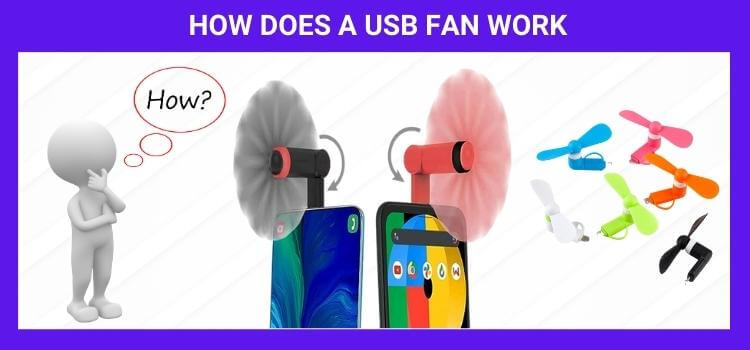As an Amazon Associate I earn from qualifying purchases.

USB fans have become increasingly popular due to their portability, energy efficiency, and ease of use. But have you ever wondered how these tiny devices provide a refreshing breeze? In this article, we’ll delve into the inner workings of a USB fan and explore the science behind it. We’ll cover everything, from the components that power it to the various types available on the market. So, let’s dive in and understand how a USB fan works.
How Does a USB Fan Work?
A computer, power bank, or another USB-enabled device may have a USB fan attached to it as a modest cooling device. They work by transforming electrical energy into mechanical energy, which drives the rotation of the fan blades and creates airflow.
The primary components of a USB fan are as follows:
USB Connector:
The USB connector is the starting point of the USB fan. It plugs into a USB port on your device and draws power from it.
Motor:
The motor is the heart of the USB fan. It converts electrical energy from the USB port into mechanical energy, causing the fan blades to rotate.
Fan Blades:
The fan blades are responsible for creating the airflow. As the motor spins the edges, they push air forward, generating the cooling effect.
Protective Grille:
Most USB fans have a protective grille covering the rotating fan blades to ensure safety and prevent accidents.
On/Off Switch:
Some USB fans have an on/off switch, allowing you to control the fan’s operation.
How Does a USB Fan Generate Cooling Airflow?
At first glance, a USB fan may seem simple, but it involves a well-orchestrated combination of components to produce a cooling breeze. Let’s break down the process step by step:
Power Source
The USB fan draws power from the connected USB port, which typically supplies 5 volts of electrical energy. This low voltage ensures that the fan operates efficiently while consuming minimal power.
Circuitry
The circuitry within the USB connector comes into play when the USB fan is plugged into a USB port. The electrical circuit is finished once the circuitry recognizes the power source and permits electricity to flow to the fan’s motor.
Motor Operation
At the heart of the USB fan is a small electric motor. When current flows through the engine, it generates a magnetic field that interacts with the motor’s coils. This interaction causes the motor’s shaft to rotate rapidly.
Fan Blades in Action
As the motor’s shaft rotates, the fan blades spin. These fan blades are strategically designed to provide maximum air movement while keeping noise levels minimal. The rotation of the blades generates a stream of air that flows in the fan’s direction.
Airflow Generation
As this airflow moves across our skin, it enhances the evaporation rate of sweat, thus providing a cooling effect. This is why using a USB fan on a hot day can make us feel more comfortable and refreshed.
Components of a USB Fan Explained
To better understand the mechanics behind a USB fan’s cooling process, let’s take a closer look at its main components:
USB Connector
The USB connector is the starting point of the USB fan’s operation. It is responsible for drawing power from the USB port of various devices, such as laptops, computers, and power banks.
Fan Blades
The fan blades play a crucial role in generating airflow. They are designed to move air effectively while balancing airflow and noise production. Fan blades are typically made from durable materials like plastic or metal.
Motor
The motor is the driving force of the USB fan. When electricity flows through the engine, it initiates the rotation of the shaft, leading to the movement of the fan blades and the creation of airflow.
Circuit Board
The circuit board acts as the control center for the USB fan. The device controls the electric current that powers the motor and may have added functions like adjustable speeds or the ability to move back and forth.
Understanding USB Fan Mechanics
To fully comprehend how a USB fan works, it’s essential to appreciate the mechanical interactions between its components. As the electrical current powers the motor, the motor’s rotation sets the fan blades into motion, generating much-needed airflow for cooling. The fan’s ability to cool air efficiently makes it an excellent companion for personal comfort during hot weather.
In conclusion, the mechanics of a USB fan are elegantly simple yet highly effective. The combination of its components and the science behind its operation enables it to provide cooling airflow that offers relief and comfort, particularly when the temperature rises. So the next time you plug in your USB fan, take a moment to appreciate the remarkable process that keeps you cool and refreshed.
Different Types of USB Fans
USB fans come in various designs and types, each catering to specific needs and preferences. Here are some common types of USB fans:
- Portable Handheld USB Fans: These small, lightweight fans are perfect for personal use. They often come with a lanyard or clip, making them easy to carry around.
- Desk USB Fans: Desk USB fans are designed to sit on your desk and provide steady airflow while you work.
- Flexible Neck USB Fans: The adjustable neck on these fans allows you to position it however you choose to control airflow.
- USB Bladeless Fans: Innovative technology allows bladeless fans to provide a smooth stream of air without any visible blades, making them suitable for use around children and animals.
- USB Tower Fans: USB tower fans are taller and suitable for cooling larger spaces.
Advantages of USB Fans
USB fans offer several advantages that make them popular among users. Let’s explore some of these benefits:
- Portability: Their compact size and USB compatibility make them highly portable, allowing you to use them on the go.
- Energy Efficiency: USB fans consume minimal power, making them energy-efficient and environmentally friendly.
- Versatility: You can use USB fans with various devices like laptops, power banks, and smartphones.
- Quiet Operation: Most USB fans operate quietly, ensuring they don’t disturb your work or sleep.
- Cost-Effective: Compared to traditional fans, USB fans are more budget-friendly, making them an affordable cooling option.
Making the Most of Your USB Fan
To optimize the performance and lifespan of your USB fan, follow these tips:
- Keep It Clean: Regularly clean the fan blades and grille to prevent dust accumulation, which can hinder airflow.
- Positioning Matters: Place the fan strategically to direct airflow where you need it the most.
- Avoid Overheating: If your device gets too hot, use a USB fan to cool it down and prevent potential damage.
- Use USB Adapters: Their utility increases because various USB devices, such as wall adapters, can power USB fans.
- Opt for Bladeless Fans: If you have pets or small children, bladeless USB fans offer a safer alternative.
FAQs
Small, transportable USB fans run on a USB port. They are a convenient way to stay cool in hot weather, and they can be used in various settings, such as at the office, at home, or while traveling.
There are a variety of different types of USB fans available, including:
Desk fans: These fans are designed to sit on a desk or table. They typically have a base that allows them to be tilted, so you can direct the airflow where you want it.
Clip-on fans: These fans can be clipped onto different surfaces like desks, chairs, or strollers. They are a good option for people who want to keep cool while on the go.
Handheld fans: These are small and portable, so they can be taken wherever you go. They are a good option for people who want to stay cool while working out, walking, or sitting in a hot car.
Rechargeable fans: These fans have a battery that can be conveniently charged using a USB connector. They are a good option for people who want a fan that they can use without worrying about running out of power.
USB fans work by using the power from a USB port to power a small electric motor. The motor turns a shaft, which is connected to the fan blades. The fan blades then spin, creating a breeze. The speed of the motor determines the amount of air the fan blows.
The lifespan of a USB fan depends on some factors, including the quality of the fan, how often it is used, and how well it is cared for. However, most USB fans will last for several years with regular use.
There are some benefits to using USB fans, including:
They are portable and easy to use.
They are a more energy-efficient way to stay relaxed than using an air conditioner.
They can be used in a variety of settings.
They are relatively inexpensive.
Conclusion
In conclusion, understanding how a USB fan works empowers you to make the most of this compact and versatile cooling device. USB fans efficiently provide a steady airflow by converting electrical energy into mechanical energy, keeping you comfortable during hot days or while working on your computer. Their portability, energy efficiency, and various designs make them an excellent choice for personal cooling needs. With proper maintenance and positioning, your USB fan can serve you well for a long time. So, stay calm and comfortable with your trusty USB fan!
Related Post
Amazon and the Amazon logo are trademarks of Amazon.com, Inc, or its affiliates.




Leave a Reply